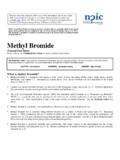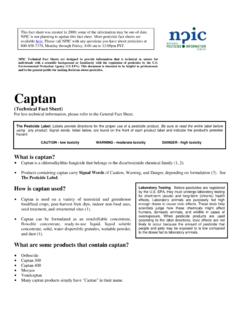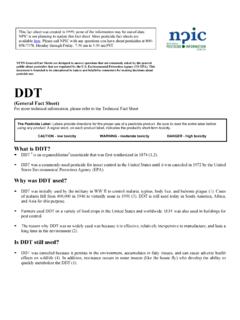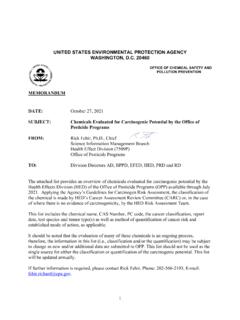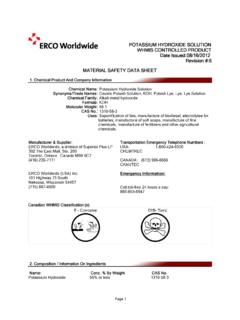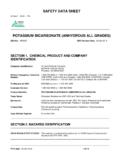Transcription of NPTN General Fact Sheets are designed to answer …
1 This fact sheet was created in 2001; some of the information may be out-of-date. NPIC is not planning to update this fact sheet. More pesticide fact Sheets are available here. Please call NPIC with any questions you have about pesticides at 800-858-7378, Monday through Friday, 8:00 am to 12:00 pm PST. NPTN General Fact Sheets are designed to answer questions that are commonly asked by the General public about pesticides that are regulated by the Environmental Protection Agency ( EPA). This document is intended to be helpful to professionals and to the General public for making decisions about pesticide use.
2 potassium Salts of fatty Acids ( General Fact Sheet). For less General information, please refer to the Technical Fact Sheet The Pesticide Label: Labels provide directions for the proper use of a pesticide product. Be sure to read the entire label before using any product. A signal word, on each product label, indicates the product's potential hazard. CAUTION - low toxicity WARNING - moderate toxicity DANGER - high toxicity What are potassium salts of fatty acids? potassium salts of fatty acids are commonly referred to as soap salts. They are used as insecticides, herbicides, fungicides, and algaecides.
3 The first pesticide product containing soap salts was registered for use in 1947 (1). potassium salts of fatty acids are produced by adding potassium hydroxide to fatty acids found in animal fats and in plant oils. fatty acids are extracted from palm, coconut, olive, castor, and cottonseed plants to form this active ingredient (2). potassium salts of fatty acids are used as multi-purpose food additives and the Food and Drug Administration (FDA) classifies them as GRAS (generally recognized as safe) (3). Residues from the use of this active ingredient, in accordance with labeling guidelines, are not anticipated to exceed levels that occur naturally, or levels that are intentionally added to food.
4 The United States Environmental Protection Agency (EPA) does not require a food tolerance for this active ingredient (1, 4). What products contain potassium salts of fatty acids? Safer Insecticidal Soap . Safer Moss and Algae Attack Concentrate . Safer Sharpshooter Weed and Grass Killer Concentrate . M-Pede Insecticide/Fungicide . How do potassium salts of fatty acids work? fatty acids penetrate an insects body covering and disrupt the cell membranes. The cell contents leak out causing the insect to dehydrate and die (5, 6). potassium salts of fatty acids are somewhat selective Laboratory Testing: Before pesticides are registered towards soft-bodied insects, such as aphids, whiteflies, by the EPA, they must undergo laboratory testing for short-term and long-term health effects.
5 Laboratory and mealy bugs. Flying adult insects with a stronger outer animals are purposely fed high enough doses to cause covering, such as ladybird beetles and bees, may be less toxic effects. These tests help scientists judge how affected by this active ingredient. However, insects in the these chemicals might affect humans, domestic immature, flightless stage of development are more animals, and wildlife in cases of overexposure. When vulnerable to the effects of this active ingredient (5, 7). pesticide products are used according to the label directions, toxic effects are not likely to occur because potassium salts of fatty acids can be toxic to plants.
6 Plants the amount of pesticide that people and pets may be that have hairy leaves may hold the soap on their surfaces exposed to is low compared to the doses fed to longer, resulting in a burn (7, 8). laboratory animals. potassium salts of fatty acids are also toxic to certain types of fungi (5, 9). LD50/LC50: A common measure of acute toxicity is the lethal dose (LD50) or lethal concentration (LC50) that causes death (resulting How toxic are potassium salts of fatty acids? from a single or limited exposure) in 50 percent of the treated animals. LD50 is generally expressed Animals as the dose in milligrams (mg) of chemical per potassium salts of fatty acids are very low in toxicity when kilogram (kg) of body weight.
7 LC50 is often ingested (1). See boxes on Laboratory Testing, LD50/LC50, expressed as mg of chemical per volume ( , and Toxicity Categories. liter (L)) of medium ( , air or water) the organism is exposed to. Chemicals are considered highly potassium salts of fatty acids are very low in toxicity by skin toxic when the LD50/LC50 is small and practically exposure (1). non-toxic when the value is large. However, the LD50/LC50 does not reflect any effects from long- term exposure ( , cancer, birth defects, or Humans reproductive toxicity) that may occur at levels Ingestion of high doses of potassium salts of fatty acids may below those that cause death.
8 Cause General stomach upset and vomiting in humans (7). potassium salts of fatty acids can be irritating to Toxicity Category (Signal Word) (10). the skin and eyes (1). Moderate Low Very Low High Toxicity Do potassium salts of fatty acids (Danger). Toxicity (Warning). Toxicity (Caution). Toxicity (Caution). cause developmental or birth Oral LD50 Less than 50 50 - 500 500 - 5000 Greater than defects? mg/kg mg/kg mg/kg 5000 mg/kg Scientists note that potassium salts of fatty acids cause reproductive and developmental effects Dermal Less than 200 200 - 2000 2000 - 5000 Greater than when administered to laboratory animals at high LD50 mg/kg mg/kg mg/kg 5000 mg/kg doses (1, 7).
9 Inhalation Less than - - 2 mg/l Greater than Scientists conclude that potassium salts of fatty LC50 mg/l mg/l 2 mg/l acids, when used in accordance with labeling guidelines, will not pose any significant hazard Eye Corrosive Irritation Irritation Minimal (1). Effects persisting for reversible effects, gone 7 days within 7 days within 24 hrs Do potassium salts of fatty acids Skin Corrosive Severe Moderate Mild or slight Effects irritation at irritation at irritation break down and leave the body? 72 hours 72 hours The body breaks down fatty acids, which provide an energy source for living cells (1, 5).
10 What happens to potassium salts of fatty acids in the environment? potassium salts of fatty acids are not persistent. The soil half-life is less than one day. Microbes in the soil rapidly break down this active ingredient (1). See box on Half-life. What effect do potassium salts of fatty Half-life is the time required for half of the compound to degrade. acids have on wildlife? fatty acids are a significant part of the normal daily diet of 1 half-life = 50% degraded mammals, birds and fish (1). 2 half-lives = 75% degraded potassium salts of fatty acids are practically nontoxic to birds 3 half-lives = 88% degraded and slightly toxic to cold-water and warm-water fish (1).
